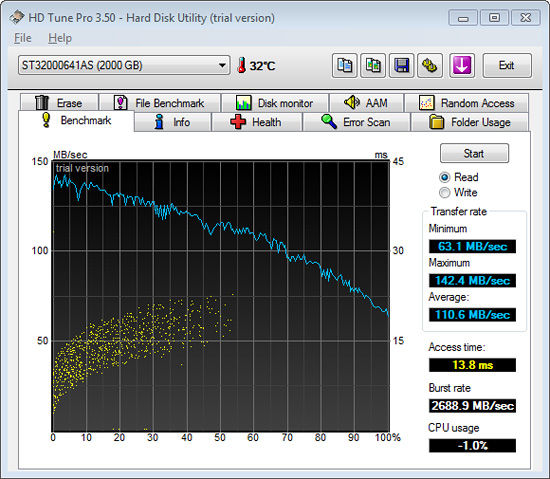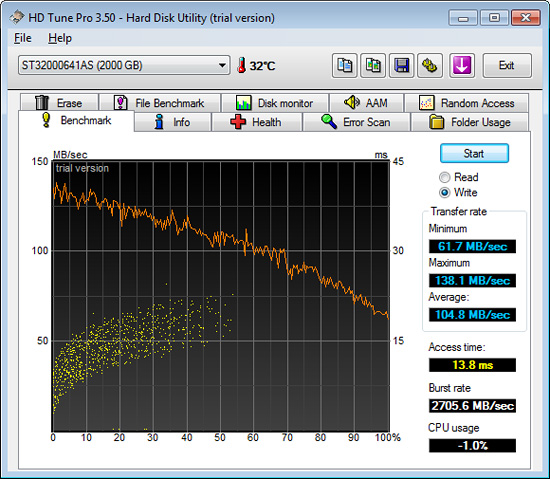Seagate Barracuda XT 2TB: SATA 6Gb/s Performance Preview
by Gary Key on October 29, 2009 12:00 AM EST- Posted in
- Storage
Seagate has finally started shipping their new Barracuda XT 2TB drives that feature the new 6Gb/s SATA interface based on SATA Revision 3.x specifications. We had an early preview of the drive a few weeks ago and finally received a production level item for review. Just as important, we now have retail motherboards from Asus and Gigabyte featuring 6Gb/s capabilities. Well at least the Marvell 88SE9123 chipset included on both motherboards is theoretically capable of 6Gb/s operation.
Asus and Gigabyte took a different approach to implementing the Marvell 9123 chipset on their motherboards. Asus’s top of the line P7P55D Premium (a very good board by the way, full review coming shortly) features a PEX PLX8613 PCIe bridge chip that will convert four of the P55’s PCIe x1 lanes (250MB/s each) into two 500MB/s lanes. While still short of the maximum theoretical 600MB/s transfer speed of the SATA 6G specifications, it will provide more than enough burst bandwidth for the first generation 6G hard drives. The benefit is that the 6G capability is always on without affecting the other capabilities of the board and the same PLX chipset will be utilized for the upcoming USB 3.0 (NEC chipset) option on their upper-end boards.
Gigabyte’s implementation will be utilizing an x8 PCIe 2.0 from the Lynnfield processor that will obviously provide more than enough bandwidth but the drawback is that CF/SLI capabilities will be disabled as only a single x8 PCIe 2.0 lane will be available to the GPU. The benefit in this approach is that the SATA 6G switch is disabled/enabled in the BIOS by the user based upon need. Since an additional hardware chipset like Asus is utilizing is not required, it should result in a slightly lower board cost. Gigabyte informed us this week that all P55A-xxx boards will feature both SATA 6G and USB 3.0 capabilities. We will compare the performance of Gigabyte’s solution against Asus’ implementation shortly.
For today’s preview we are utilizing the Asus P7P55D Premium motherboard, 8GB of GSkill’s DDR3-1600 Ripjaw memory, Asus HD5870 video card, Corsair 750HX power supply, Windows 7 x64 RTM, Western Digital Caviar Black 2TB HD, WD VelociRaptor 300GB, Intel X25-M G2 160GB SSD, and Seagate’s Barracuda XT 2TB HD. We will have a full review of both hard drives shortly with additional performance results along with temperature and noise tests.
We are utilizing the Intel 160GB SSD for our OS drive and comparing the Seagate XT drive to its closest competitor, the WD Caviar Black, on both the Intel P55 and Marvell 9123 controllers. The P55 is limited to SATA 3Gb/s operational mode when running either drive, while the Marvell controller will be operated in SATA 6Gb/s mode with the Seagate drive and in fallback 3Gb/s mode with the WD drive. We are utilizing Marvell’s latest 1027 driver and Intel’s 7.0.0.1013 driver set in AHCI mode.
HD Tune 3.50 Results -


See something strange, the read burst rate of 2766MB/s and write burst of 2705MB/s are incredible for single drive performance but like most synthetic test results, they are not a true indication of actual platform performance. The reason for these “outstanding” results is that Marvell’s latest driver allocates (dynamically) a portion of system memory for transfer cache operations. Intel’s own Matrix Storage Manager and JMicron’s latest driver set also utilize a similar approach. In fact, Windows 7 implements a similar type of caching at the kernel level that makes these driver optimizations redundant in some ways.
Marvell is using aggressive algorithms in this particular driver to read and write as much possible data out of the RAM cache as possible before relying on transfers via the hard drive’s own internal cache or reading/writing from the platter or NAND. In earlier driver sets from Marvell, they requested that Window’s write-cache buffer flushing option be disabled in order to gain the maximum benefit from the 9128 controller. From all indications, the 1027 driver automatically disables this function as our performance results were the same with it disabled or enabled.
While performance was generally up to 10% better with this driver compared to the earlier 1018/1025 driver sets, we have a problem with the write-cache buffer flush being disabled automatically. There is a potential for data loss or even file table corruption if the buffers are not flushed and written properly if power is lost or there is another problem with the system. Of course that potential problem even exists with the out of box drivers and with write-caching enabled.
Our concern is that the Marvell driver might not recognize file table priorities in the same manner that the kernel does and those journal entries will be placed into the same general cache queue with other mundane requests. That could increase the likelihood of data or table corruptions above the normal risk posed with write caching. We are still waiting on additional information about the driver design and will update our findings in the final review.










55 Comments
View All Comments
ipay - Monday, November 2, 2009 - link
Buying or making a custom cable is the exact opposite of "easy" for people who expected the drive to work as advertised.SpatulaCity - Friday, October 30, 2009 - link
I always thought there were 8 bits in a byte.6Gbps / 8 = 750MBps
am I confused or missing something?
peldor - Friday, October 30, 2009 - link
8/10 encoding.http://en.wikipedia.org/wiki/10/8_encoding">http://en.wikipedia.org/wiki/10/8_encoding
coyote2 - Thursday, October 29, 2009 - link
I'd love to see how the (budget) Hitachi 7200rpm compares to the WD Caviar Black and this Seagate XT. thanks AnandTech!dragunover - Thursday, October 29, 2009 - link
Reviews around the net show this is a great performer. Why not test more hard-drives like this one?Robear - Thursday, October 29, 2009 - link
I really like the "less synthetic" IO benches, with the file transfers and all.Standardized benchmarks are a double-edged sword. On the one hand the standardized benchmark can be reproduced and hence verified, attributing to the credibility. On the other hand, firmware can be tweaked to the benchmarks to skew benchmarks and obscure actual performance.
I'd like to see a mix of standardized and non-standardized (i.e. "Anandtech Benches") more in the future.
I'd like to see real-world scenarios, like game install times, game load times, software builds, anti-virus scanning, etc.
MadMan007 - Thursday, October 29, 2009 - link
So SATA 6Gb/s implemented by an add-on chip will do little but add cost? Great :/motigez - Thursday, October 29, 2009 - link
well done for the Storage Bench, to my opinion, this is the only test which should matter to the end user, I would strongly recommend to keep it simple, no heavy and light, only one combination, and find some way to normalize it in comparison to SSD, this would finally allow users to tell which drives are better for them, which makes a difference and worth the premium, there is nothing we can do with pure sequential numbers...and base on my experience PcMark does not tell enough about user experience,Thanks AnandTech
MrSpadge - Thursday, October 29, 2009 - link
There are 2 things to take away from this:1. SATA 3 doesn't change anything for current HDDs. That's just as expected, because they'd have done something wrong if the current SATA 2 interface would already have been a limit. The push to higher performance interfaces always preceded their need - and that's good, but nothing to get excited about (either positive or negative).
2. Seagate's performance is.. "mixed", if I choose the most euphemistic words. That's been the case since many years and I still don't understand why people would like them.
chizow - Thursday, October 29, 2009 - link
As I stated a few months ago when news of this 2TB drive broke, SATA 6.0 is hardly needed on mechanical drives as they're not even fully utilizing SATA 3.0, only a slight benefit from peak rates as this bench shows.Its quite clear the Marvell controller is also bottlenecked by these mechanical drives and overall less efficient than the Intel controller. The HD to HD transfers show the mechanical drives are typically the bottleneck, but the Intel drives write speeds are also bottlenecks in the HD to SSD benches. The only scenario the mechanical drives aren't bottlenecked is in the SSD to HD test where the high SSD reads allow for the higher mechanical drive transfers.
I would've liked to have seen HD to SSD transfer results with an SSD with faster sustained write speeds, like one of the Indilinx drives that get ~200MB/s writes. I would've also liked to have seen all SSDs tested on one of these SATA 6.0 controllers to truly isolate its performance compared to SATA 3.0. I understand its beyond the scope of this review, it just seems like neither the controller nor the drive are up to the task of achieving potential performance.